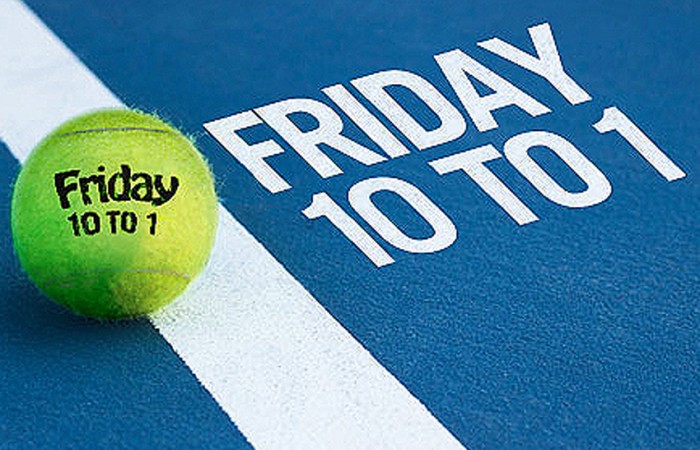Friday 10 to 1: Laver’s greatest moments
In this week's Friday 10 to 1, we reflect on the 10 greatest moments that have helped position Rod Laver as arguably the Greatest of All Time
Melbourne, Australia, 28 September 2012 | tennis.com.au

After last week looking at the 10 greatest moments that have defined Roger Federer’s career, this week we reflect on the best 10 events that have helped position Rod Laver as arguably the Greatest of All Time. We’ll take you through them in chronological order:
10. First Grand Slam title – Australian Open 1960
After winning the US Open junior singles in 1956 and reaching the Wimbledon final in 1959, Laver delivered on his immense promise and talent by claiming his first Grand Slam title at the Australian Open in 1960. Held that year at the Milton courts in Brisbane, Laver recovered from two-sets-to-love down to defeat compatriot and top seed Neale Fraser 5-7 3-6 6-3 8-6 8-6. In the semifinals, Laver had overcome No.2 seed Roy Emerson 7-5 in the fifth set.
9. Calendar Year Grand Slam, 1962
Laver’s victory in Australia in 1960 acted somewhat as the breaking of the ice, with the Queenslander winning at Wimbledon in 1961 before going on a tear in 1962 by scooping all four major titles in the one year. And he did so relatively convincingly – at the three grasscourt majors in Australia, Wimbledon and New York, he barely dropped a set. The French Open proved a tougher assignment, with Laver needing five sets to win his quarterfinal, semifinal and final matches.
8. Turned pro – late 1962
Following his Grand Slam feat, Laver made the tough decision to turn professional at the end of 1962. It was a move that would prevent him contesting in future Grand Slam events and Davis Cup – then the domain of amateurs only – and force him into a life of professional touring, separate events and “one night stands”, which were exhibition matches staged in different cities each night, rather than tournament play. However, this decision allowed him to legitimately earn money from his sport and career of choice, and along with other amateurs-turned-pro he paved the way to Open tennis. Writes Bud Collins on atpworldtour.com: “His appearance (saved) the sagging professional game, a stimulus to keeping it breathing until opens arrived in 1968. It was a life of one-nighters, but Pancho Gonzalez was no longer supreme.”
7. Success on Pro Circuit, 1963–1967
After initially being overshadowed by compatriot Ken Rosewall on the Pro Circuit, Laver would go on to dominate, winning nine Pro Slam events – including four straight Wembley Pro tournaments from 1964–67 – and capturing the Pro Slam in 1967, comprising the US, French, Wembley and Wimbledon Pro titles.
6. Second Calendar Year Grand Slam, 1969
Once amateurs and pros were united thanks to the advent of Open tennis in 1968, Laver set about cementing his dominance over a larger group of rivals. He did so in stunning fashion the following year by capturing his second calendar year Grand Slam, the only player in history to achieve such a feat. His 1969 Grand Slam is arguably more impressive than his 1962 set given the greater depth of competition and the greater number of tense battles he had to survive to claim the prize. You can see footage from all four of his winning Grand Slam finals below.
Watch highlights of Laver’s victory in the 1969 Wimbledon final
5. 31-consecutive wins at Wimbledon
With his triumph at Wimbledon in 1969 to go with titles in 1961, 1962 and 1968, Laver had won the Championships the past four times he had been eligible to enter, and had built up quite the winning streak at the All England Club. This extended to 31 matches before Brit Roger Taylor stopped the run in the fourth round in 1970. It was the first time in his past seven visits to Wimbledon that Laver had failed to reach the final, after also finishing runner-up in 1959 and 1960. His streak of 31 match wins at SW19 remained the record until Bjorn Borg won his fifth straight Wimbledon title in 1980.

4. Ranked year-end world No.1 from 1964–1970
Although official ATP rankings did not come into existence until 1973, player rankings were determined at year’s end by journalists and other tennis panels. And among the pundits, Laver was, unofficially, the world’s best player for seven straight years (co-ranked No.1 with Ken Rosewall in 1964, and with Rosewall and John Newcombe in 1970).
3. Helped Australia win the 1973 Davis Cup
Even though the Open Era permitted professionals to play in all tournaments, they weren’t allowed to compete in Davis Cup until 1973. That year, Laver returned after 11 years away from the competition and along with John Newcombe helped to crush the United States 5-0 in Cleveland. Australia’s victory broke a run of five straight years of the US winning the competition, and saw Laver become part of a fifth winning Davis Cup team (following triumphs in 1959–62).
2. International Tennis Hall of Fame induction, 1981
Laver’s illustrious career was recognised with his induction into the International Tennis Hall of Fame in 1981. Chief career stats include 11 Grand Slam singles titles (among 20 major titles in all), five Davis Cup victories with an overall competition record of 20-4, 184 singles titles (47 pro titles among them) and a career that spanned an incredible 23 years.
1. Melbourne Park’s Centre Court named in his honour
Formerly referred to as Centre Court, the Australian Open’s premier court officially became known as Rod Laver Arena on 16 January 2000, in honour of Laver’s remarkable career. The big lettering, visible from several vantage points around the city and which glow at night, are a prominent reminder of the Queenslander’s stratospheric achievements in the sport.